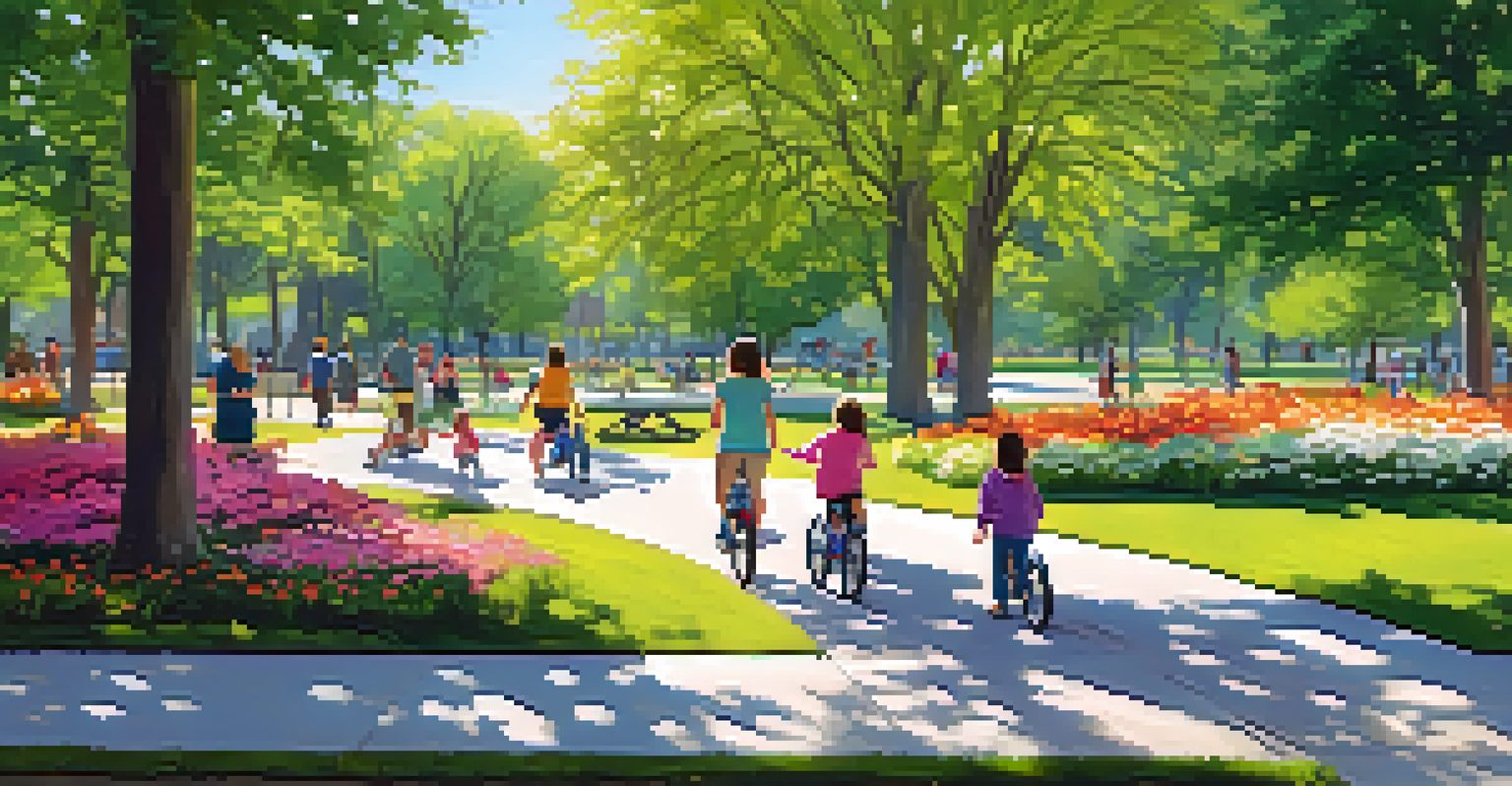Understanding the Importance of Walkability in Investments

What is Walkability and Why Does it Matter?
Walkability refers to how friendly an area is to walking, encompassing factors like sidewalks, crosswalks, and overall accessibility. It’s more than just the physical space; it’s about creating a pleasant experience for pedestrians. Places with high walkability foster social interaction and community engagement, making them more desirable for residents and investors alike.
Walkability is a key ingredient in the recipe for a vibrant community.
Investors should view walkability as a key indicator of a neighborhood's vitality. A walkable area often correlates with higher property values and can attract a diverse group of potential tenants or buyers. For example, neighborhoods with nearby cafes, parks, and shops tend to have a stronger sense of community, which can lead to lower vacancy rates and higher rental income.
Moreover, walkability is increasingly becoming a priority for homebuyers. With more people seeking convenience and lifestyle-oriented living, properties in walkable areas often sell faster and at a premium. Thus, understanding walkability can provide investors with a competitive edge in the market.
The Economic Impact of Walkable Neighborhoods
Walkable neighborhoods not only enhance quality of life but also contribute significantly to local economies. When people can easily walk to shops or services, they tend to spend more time and money in their local area. This economic activity supports businesses and can lead to the development of new ones, creating a thriving environment for investment.

Furthermore, areas with high walkability can lower transportation costs for residents, making them more appealing. Families can save money on vehicle expenses, which can then be redirected toward housing or local spending. This economic benefit can enhance the attractiveness of investing in such neighborhoods for developers and investors alike.
Walkability Boosts Property Value
High walkability in neighborhoods often correlates with increased property values and lower vacancy rates, attracting more residents and investors.
Local governments have recognized these benefits and are often more willing to invest in infrastructure improvements in walkable areas. This can include better public transport, enhanced sidewalks, and public spaces, all of which contribute to increasing property values and investment opportunities.
Walkability and Environmental Sustainability
An often-overlooked aspect of walkability is its positive impact on the environment. Walkable neighborhoods encourage less reliance on cars, leading to reduced greenhouse gas emissions and improved air quality. This shift not only benefits the environment but also aligns with the growing trend of sustainability among consumers and investors.
The best communities are those where one can walk to shop, work, and play, reducing the need for cars and enhancing quality of life.
Additionally, more walkable spaces often incorporate green areas, which enhance biodiversity and provide residents with natural places to relax and unwind. For instance, neighborhoods with parks and tree-lined streets create inviting atmospheres that attract both residents and visitors, further boosting local economies and property values.
Investors who prioritize environmentally friendly developments can attract eco-conscious buyers and renters. As the demand for sustainable living options rises, properties in walkable areas are likely to remain in high demand.
The Connection Between Walkability and Health
Walkability is tightly linked to public health, as it promotes physical activity and a healthier lifestyle. In walkable neighborhoods, residents are more likely to engage in walking, jogging, or biking, which can lead to lower rates of obesity and related health issues. This aspect is particularly appealing to families and individuals seeking healthier living environments.
Moreover, walkable areas often feature access to recreational facilities, parks, and community events that encourage active lifestyles. This integration of leisure and fitness into daily life enhances community well-being, making these neighborhoods desirable for potential homebuyers and tenants.
Economic Benefits of Walkable Areas
Walkable neighborhoods enhance local economies by encouraging residents to spend more time and money in their communities.
Investing in walkable neighborhoods can thus be seen as a commitment to promoting health and well-being. As awareness of health issues grows, properties in such areas may see increased value and demand.
Demographic Trends Favoring Walkable Areas
Recent demographic shifts indicate a growing preference for urban living, particularly among younger generations. Millennials and Gen Z are increasingly drawn to walkable neighborhoods that offer convenience, accessibility, and vibrant lifestyles. This trend is reshaping the real estate market, making walkable areas more attractive for investors.
As these demographics prioritize experiences over material possessions, they often seek out neighborhoods with lively social scenes, cultural amenities, and the ability to walk to work or leisure activities. Investors should take note of these preferences when considering properties, as they can significantly influence property values.
Additionally, empty nesters are also looking to downsize and move into walkable communities where they can remain active and engaged. This convergence of interest from diverse age groups further solidifies the investment potential in walkable neighborhoods.
Challenges in Assessing Walkability
While the benefits of walkability are clear, assessing it isn't always straightforward. Different neighborhoods may have varied definitions of what constitutes walkability, influenced by local culture, geography, and infrastructure. Investors must recognize these nuances when evaluating potential properties.
Additionally, not all metrics for measuring walkability are created equal. Tools like Walk Score can provide a quick gauge, but a deeper analysis is needed to understand the quality of pedestrian infrastructure and community dynamics. For instance, a high Walk Score doesn’t always equate to a vibrant neighborhood if safety and accessibility are lacking.
Healthier Living Through Walkability
Walkable areas promote physical activity and access to recreational facilities, contributing to improved public health among residents.
Therefore, investors should engage with local communities and conduct thorough research to truly understand the walkability of an area. This comprehensive approach will lead to more informed investment decisions.
Future Trends in Walkability and Investments
Looking ahead, the importance of walkability in real estate investments is only expected to grow. As cities and towns continue to evolve, the demand for walkable spaces will likely increase, driven by changing consumer preferences and urban planning initiatives. Investors who recognize this trend will position themselves advantageously in the market.
Innovative developments, such as mixed-use properties that combine residential, retail, and recreational spaces, are becoming more common. These developments cater to the desire for convenience and community, often resulting in higher property values and occupancy rates. Investors should keep an eye on such trends to identify promising opportunities.

In summary, understanding the future of walkability can lead to smarter investment choices. By aligning with consumer preferences and urban sustainability goals, investors can help shape the neighborhoods of tomorrow while reaping the benefits today.